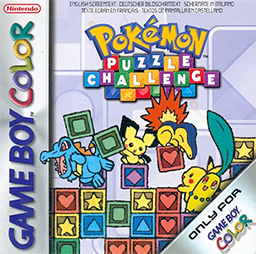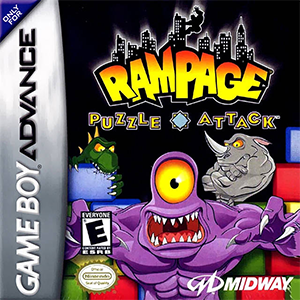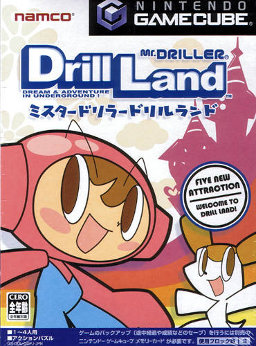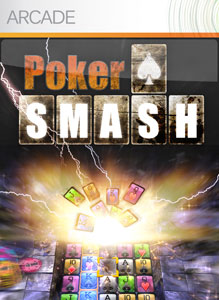Related Research Articles

Tetris Attack, also known as Panel de Pon in Japan, is a puzzle video game developed by Intelligent Systems and published by Nintendo for the Super Nintendo Entertainment System. A Game Boy version was released a year later. In the game, the player must arrange matching colored blocks in vertical or horizontal rows to clear them. The blocks steadily rise towards the top of the playfield, with new blocks being added at the bottom. Several gameplay modes are present, including a time attack and multiplayer mode.

Wrecking Crew is an action game developed and published by Nintendo. Designed by Yoshio Sakamoto, it was first released as an arcade video game for the Nintendo VS. System in 1984, titled Vs. Wrecking Crew with a simultaneous two-player mode. It was released as a single-player game for the Family Computer (Famicom) console in 1985, and as a launch game for the Nintendo Entertainment System (NES) later that year. A sequel, Wrecking Crew '98, was released in Japan in 1998 for the Super Famicom.

Pokémon Puzzle League is a puzzle video game in the Puzzle League series developed by Nintendo Software Technology and published by Nintendo for the Nintendo 64. Released in North America on September 25, 2000, and in Europe on March 2, 2001, its Puzzle League-based gameplay has a focus on puzzle-based strategy in the game's grid-based format. To advance to new levels, players are required to combat the game's trainers and gym leaders, similar to the ones featured in Pokémon Red, Blue, and Yellow. One of several games based on the Pokémon anime, it features lead protagonist Ash Ketchum, his Pikachu, his companions Brock and Misty, the Kanto Gym Leaders, and other characters from the series.

Dr. Robotnik's Mean Bean Machine is a falling block puzzle game developed by Compile and published by Sega. It was released for the Sega Genesis / Mega Drive in North America and Europe in November 1993, and ported to the Game Gear in 1993 and Master System in 1994.

Pokémon Puzzle Challenge is a puzzle video game developed by Intelligent Systems and published by Nintendo for the Game Boy Color. Released in Japan on September 21, 2000; in North America on December 4, 2000; and in PAL regions on June 15, 2001, it is the second Pokémon-themed entry in the Puzzle League series. While its Nintendo 64 counterpart Pokémon Puzzle League is visually based on the Pokemon anime, Puzzle Challenge instead draws inspiration from the Pokémon Gold and Silver games. The game features multiple modes of play and support for competitive play between two players. Puzzle Challenge was later digitally re-released via the Nintendo 3DS's Virtual Console line on November 6, 2014.

Puyo Pop Fever is a 2003 puzzle video game developed by Sonic Team and published by Sega. It is the fifth main installment in the Puyo Puyo puzzle game series and the second Puyo Puyo game to be programmed by Sonic Team after Puyo Pop. This was the start of the what can be considered a reboot of the Puyo Puyo franchise, with this entry's plot revolving around Professor Accord losing her flying cane. Sega, which acquired the series' rights from Compile in 1998, published all the Japanese releases of the game, and also published the arcade and GameCube versions internationally. The game was scarcely released internationally, and certain versions were released by other publishers in those areas. Only the arcade, GameCube, and Nintendo DS versions were released in North America. Europe received all three versions plus the PlayStation 2, Xbox, Game Boy Advance, and PlayStation Portable versions. The Dreamcast version, released exclusively in Japan, was the last Dreamcast game developed by Sonic Team, the last first-party title released on the platform, as well as the final first-party title by Sega. was ported from the arcade version. The Dreamcast version is the only console version to use sprites in place of 3D models.

Tetris & Dr. Mario is a 1994 puzzle video game compilation published by Nintendo for the Super Nintendo Entertainment System. It contains enhanced remakes of Tetris (1989) and Dr. Mario (1990), which were originally released for both the Nintendo Entertainment System and Game Boy in North America. Both games include split-screen multiplayer and a "Mixed Match" mode that transitions between the two games.

Super Puzzle Fighter II Turbo, released in Japan as Super Puzzle Fighter II X, is a tile-matching puzzle video game released in 1996 for the CP System II (CPS2) arcade board, by Capcom and its Capcom Coin-Op division. The game's title is a play on Super Street Fighter II Turbo, as there were no other Puzzle Fighter games at the time, and the game includes music and interface elements spoofing the Street Fighter Alpha and Darkstalkers games. It was a response to Sega's Puyo Puyo 2 that had been sweeping the Japanese arcade scene.

Tetrisphere is a puzzle video game developed by H2O Entertainment and published by Nintendo for the Nintendo 64. It was released in North America on August 11, 1997, and in PAL regions in February 1998. The game, originally named Phear, was slated for release on the Atari Jaguar in early 1995, but was reworked into a Tetris game for the N64 after Nintendo obtained its publishing rights.

Pac-Attack, also known as Pac-Panic, is a 1993 falling-tile puzzle video game developed and published by Namco for the Super Nintendo Entertainment System and Sega Genesis. Versions for the Game Boy, Game Gear and Philips CD-i were also released. The player is tasked with clearing out blocks and ghosts without them stacking to the top of the playfield — blocks can be cleared by matching them in horizontal rows, while ghosts can be cleared by placing down a Pac-Man piece that can eat them. It is the first game in the Pac-Man series to be released exclusively for home platforms.

Nintendo Puzzle Collection is a 2003 video game compilation published for the GameCube in Japan by Nintendo. It includes updated versions of three Nintendo-published puzzle video games released for older systems — Yoshi's Cookie (1992), Panel de Pon (1995), and Dr. Mario 64 (2001) — featuring updated graphics and music, alongside four-person multiplayer. The player can download one of the games to their Game Boy Advance via the GameCube – Game Boy Advance link cable.

Rampage Puzzle Attack is a puzzle game for Game Boy Advance, developed by Finnish development house Ninai Games and published by Midway Games.

Magical Tetris Challenge is a puzzle game by Capcom for the Nintendo 64, Game Boy Color, and PlayStation. It is a version of Tetris featuring Disney characters. It is one of the few Nintendo 64 games to be entirely in 2D.

Mr. Driller Drill Land is a 2002 puzzle video game developed and published in Japan by Namco for the GameCube. It is the fifth entry in the Mr. Driller video game series, and the second developed for a Nintendo platform following Mr. Driller A. Controlling one of seven characters, the player must make it to the bottom of each stage by destroying colored blocks, which can connect to each other and form chain reactions. The game is divided into five different modes themed as amusement park attractions, which feature new mechanics such as enemies, items and different block types.

Puyo Puyo! 15th Anniversary is a puzzle video game of the Puyo Puyo series, developed by Sonic Team and published by Sega for the Nintendo DS in 2006, as well as PlayStation 2, PlayStation Portable, and Wii in 2007. It has not been released outside of Japan for any consoles. This is the first Puyo Puyo game to be released on the Wii console.

Planet Puzzle League, known as Puzzle League DS in Europe, and as Panel de Pon DS in Japan, is a video game for the Nintendo DS handheld video game console in the Puzzle League Panel de Pon visual matching puzzle game series. In North America, Planet Puzzle League is part of the Touch! Generations brand; in Japan, Panel de Pon DS is marketed in the general Touch! brand. The publisher for the game is Nintendo, and the developer is Nintendo's second-party developer Intelligent Systems, creator of the original Panel de Pon and its cult classic English-language adaptation Tetris Attack. The game was released in Japan on April 26, 2007 in North America on June 4, 2007, and in Europe on June 29, 2007.

Poker Smash is a puzzle game developed by American independent software developer Void Star Creations for the Xbox 360's Xbox Live Arcade service and iPhone OS. The title was officially announced during Microsoft's E3 2007 press conference and was released on February 6, 2008. A Microsoft Windows release was announced for 2013, but never happened.

Koro Koro Puzzle Happy Panechu! is a puzzle video game software developed and published by Nintendo for the Game Boy Advance. It was released only in Japan on March 8, 2002. It is the first Game Boy Advance title that uses a tilt-sensor chip.

Tetris: Axis, released as Tetris in some regions, is a puzzle video game developed by Hudson Soft and Bandai for the Nintendo 3DS. The game was released in all regions in October 2011 and was published by Namco Bandai Games in Japan, Nintendo in North America, and Tetris Online in Europe and Australia.

Puzzle Link is an Arcade-style puzzle video game for the Neo-Geo Pocket and Neo-Geo Pocket Color. It was developed by TUG and published by SNK. It was first released as a black-and-white Japanese exclusive for the Neo-Geo Pocket in 1998, and then later as a colorful worldwide launch title for the Neo-Geo Pocket Color in March 1999. It was followed by a sequel, Puzzle Link 2, which first released in Japan in November 1999.
References
- 1 2 3 "Planet Puzzle League" (Press release). Nintendo Europe. Retrieved 2007-09-02.
- ↑ Wong, Alistair (July 20, 2020). "Panel de Pon 64 Prototype Found and Shared on YouTube". Siliconera . Enthusiast Gaming. Archived from the original on 2020-07-23. Retrieved 2020-07-25.
- ↑ ちょっとパネルでポン (in Japanese). Nintendo. Retrieved 2009-01-28.
- ↑ "Animal Crossing: New Leaf's new minigames harken back to the series' past". Polygon. 2 November 2016. Retrieved 2016-11-02.